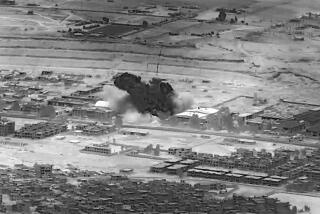PERSPECTIVE ON THE GULF WAR : The Case of the Missing Air Force : Iraq’s 700-plane armada is in hiding, safe from high-tech air assault, reserving its punch for a nasty ground war.
- Share via
It started out like a Tom Clancy kind of war. The first blow was struck by F-117 Stealth fighters slipping in under Iraqi radar as slickly as in any technothriller. Tomahawk cruise missiles flew off battleships with the regularity of planes departing an airport, while videotape from bombardier cameras showed laser-guided bombs flying to the weakest points of hardened targets with the inevitability of beads sliding down a taut string. The first Patriot missile was fired and neatly intercepted a solitary Scud above Dhahran. High-tech weaponry seemed to be exacting a terrible price from the Iraqi armed forces, while holding coalition losses to a few fighters.
Then reality set in. After three days of aerial combat it was easy to discern stagnation creeping into the allied view of the war: Reported losses of coalition aircraft climbed to 10 and stopped; targets hit in the first waves and presumed destroyed had to be “revisited.” Most disturbing of all, the number of Iraqi warplanes destroyed had stabilized at a handful, of which only three were said to have been caught on the ground.
Given the massive opening attack on Iraq and its concentration on the air force, many more of Iraq’s 700 warplanes should have been eliminated, even in revetted shelters. With U.S. superiority in hardware and training, the ratio of kills in the air should have been close to the 10-to-1 advantage the Israelis had against the Syrian air force in 1973. Instead, Iraqi defenses--air and ground--were able to extract an almost even exchange of planes and pilots. By Monday, the coalition command was reporting 17 Iraqi craft downed and 14 from the allied wing.
Control of the air has always been essential to the American style of combat, but air superiority does not just entail executing strikes with low losses. It also requires the ability to deny the enemy the use of the sky; this the coalition has not yet demonstrated.
Reports on the second and third day of combat indicated that the Iraqi air force had withdrawn to the north of the country, there to hide in hardened shelters. American briefers maintained that the aerial threat had been neutralized so long as enemy planes stayed on the ground, no matter where they were located. That assessment is valid, to the extent that forcing the enemy to seek cover for the moment permits the coalition to bomb hardened targets without interference from the air. However, if Iraq’s planes stay out of the battle, its anti-aircraft missiles and artillery have a free fire zone and can shoot at anything that flies.
The survival of the Iraqi air force to fight another day may have ominous consequences for the coalition strategy. Well dug-in troops, even the low-quality conscripts in the triangular fortresses on the Kuwait-Saudi border, are difficult to dislodge by bombardment. “Softening up” failed to destroy German or Allied trench defenses in World War I; it did not succeed in dislodging the Japanese on Iwo Jima. With almost mathematical certainty, a ground assault against the Iraqi ramparts will be necessary, but it will be dangerous because the Iraqi air force remains an air fleet in being, one that can emerge at the moment the center of gravity of the coalition ground attack becomes apparent.
The first rupture in Iraqi lines will be just one tank wide. In the moments that follow, allied armor will pour through the gap, attempting to peel back the enemy’s forces to create an opening a mile or more long. Then, when the coalition forces are committed, Iraq’s hundreds of surviving aircraft will strike, probably laden with poison gas, anti-armor and anti-personnel bombs. Nuclear weapons cannot be excluded.
Even if protective suits keep deaths from gas to a small number, fighting in that garb is debilitating. Slowed by the need to seal up against gas, the allied force will lose the shock effect which should have carried it to Kuwait city, and it will become vulnerable to the artillery batteries of Iraq, the principal killing weapon of an army famous for its ability to dig in and hold territory.
The techno-euphoria of the opening hours, before the Scud attacks against Israel and Saudi Arabia, when it seemed as if the Gulf War would be decided by robots with few Western casualties, has passed. The coalition’s failure to destroy Iraqi air power, together with the proven tenacity of Iraqi soldiers, surely implies that the war will be decided on the ground. Before the coalition prevails, infantry and armored forces will fight and bleed as they have for centuries; this war will be neither short nor antiseptic.
More to Read
Sign up for Essential California
The most important California stories and recommendations in your inbox every morning.
You may occasionally receive promotional content from the Los Angeles Times.













